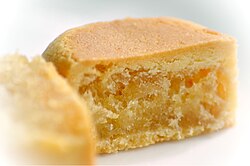Taiwanese sweet pastry
Pineapple cake (Chinese: 鳳梨酥; pinyin: fènglísū; Taiwanese Hokkien: 王梨酥 ông-lâi-so͘) is a Taiwanese sweet traditional pastry and dessert containing butter, flour, egg, sugar, and pineapple jam or slices.
History
Both pineapple cake and pineapple tart likely came into fruition around the 16th century when the pineapple, a fruit native to South America, was introduced by Portuguese merchants to the region.[2] Around this time, the Portuguese established a presence in places such as Malacca, Singapore and Taiwan, which they referred to as now archaic name "Formosa" for the island.[3]
During the Japanese colonial era, the pineapple fruit became a critical component of Taiwan's economy during which Japanese industrialists imported a wide variety of pineapple cultivars and established numerous processing plants.[4]
By the late 1930s, Taiwan had become the third-largest exporter of pineapples in the world.[4] However, when pineapple production in Taiwan shifted toward domestic sales and use of fresh pineapple, local bakeries sought to use this surplus in pastries.[5] While pineapple cakes had historically been produced as a ceremonial food, a combination of governmental promotion and globalization popularized the pineapple cake. Pineapple cakes have become one of the top-selling souvenirs in Taiwan.[6]
Since 2005, the Taipei City Government has run an annual Taipei Pineapple Cake Cultural Festival to foster the growth the local tourism industry and promote sales of the pineapple cake.[7][8] In 2013, the revenue from Taiwan's pineapple cake bakeries totaled NT$40 billion (US$1.2 billion), and sales of pineapple cakes have also bolstered agricultural economies in rural parts of the country.[9][5]
Symbolism
In Taiwanese Hokkien, "pineapple" (王梨; ông-lâi) sounds similar to a phrase meaning "to come forth, prosperous and thriving" (旺來; ōng-lâi).[10] This phrase conveys the hope that many children will be born to the family. As a result, pineapple cakes are often given as engagement gifts, or simply as well-wishing presents in an everyday context.[citation needed] Today, pineapple cake is considered one of Taiwan's culinary symbols.[11]
Varieties
Contemporary pineapple cake bakeries have created variations on the traditional pineapple cake. The filling may also incorporate preserved egg yolks or other dried fruits such as cranberries or strawberries.[12]
Bakeries may also add winter melon to the pineapple jam. This practice was initially an effort to make the tart pineapple filling more palatable.[citation needed] However, in contemporary bakeries, adding winter melon to the filling may be seen as an indicator of lower quality.[9]
The annual Taipei Pineapple Cake Cultural Festival often features a contest in which bakeries compete to create pineapple cakes that incorporate unconventional ingredients, such as rice or Taiwanese tea.[7][8]
Making
The outer skin of traditional pineapple cake is made of lard, and the filling is mostly made of pineapple mixed with winter melon. [13] In recent years, many merchants have used pure pineapple to make fillings. Although its taste is not as dense and soft as the winter melon filling, the unique and rich fruity flavor with such sweet and sour taste of pure pineapple filling are incomparable with winter melon filling.


